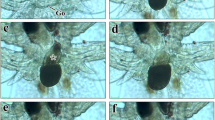Abstract
The eggs of African mouth-brooders are of unusual size and shape. Studying their development may help to more clearly understand epiboly, gastrulation, and the relation between enveloping layer (periderm) and epidermis. When epiboly has progressed over just one fifth of the yolk mass, the germ ring and embryonic shield are already well established. Behind the germ ring very few deep cells are present at this early stage of epiboly, except in the embryonic shield. When the blastodisc covers the animal half of the yolk mass, the future body is already well established with notochord, somites and developing neural keel. Apart from these structures, no deep cells can be detected between enveloping layer and yolk surface; not even a germ ring remains behind the advancing edge of the enveloping layer. Epiboly over the greater part of the yolk is achieved only by the enveloping layer and the yolk syncytial layer. As the margin of the enveloping layer begins to reduce its circumference when closing around the vegetal pole, groups of cells in the advancing edge become spindle-shaped, with a single cell in between of each of these groups broadening along the edge. The enveloping layer (called periderm after epiboly) remains intact until after hatching, when, together with the underlying ectoderm, it forms the double-layered skin of the larval fish. Thereafter, cells deriving from the subperipheral ectoderm gradually replace the decaying periderm cells to form the final epidermis. Thus, in the cichlids studied, the enveloping layer alone forms the yolk sac to begin with, and it covers the larval body until some days after hatching.
Similar content being viewed by others
References
Anderson TF (1951) Technique for the preservation of three-dimensional structure in preparing specimens for the electron microscope. Trans NY Acad Sci 13:130–134
Ballard WW (1966) The role of the cellular envelope in the morphogenetic movements of the teleost embryos. J Exp Zool 161:193–200
Ballard WW (1973) A new fate map for Salmo gairdneri. J Exp Zool 184:49–74
Baumann M, Sander K (1984) Bipartite axiation follows incomplete epiboly in zebrafish embryos treated with chemical teratogens. J Exp Zool 230:363–376
Betchaku T, Trinkaus JP (1978) Contact relations, surface activity, and cortical microfilaments of marginal cells of the enveloping layer and of the yolk syncytial and yolk cytoplasmic layers of Fundulus before and during epiboly. J Exp Zool 206:381–426
Bouvet J (1976) Enveloping layer and periderm of the trout Salmo trutta fario L. Cell Tissue Res 170:367–382
Fleig R (1990) Gastrulation in the zebrafish Brachydanio rerio (Teleostei) as seen in the SEM. In: Marthy HJ (ed) Experimental embryology in aquatic plants and animals. Plenum Press, New York, pp 329–338
Hisaoka KK, Battle HI (1958) The normal developmental stages of the zebrafish, Brachydanio rerio (Hamilton Buchanan). J Morphol 102:311–328
Keller RE, Trinkaus JP (1987) Rearrangement of enveloping layer cells without disruption of the epithelial permeability barrier as a factor in Fundulus epiboly. Dev Biol 120:12–24
Kimmel CB, Law RD (1985) Cell lineage of zebrafish blastomeres II. Formation of the yolk syncytial layer. Dev Biol 108:86–93
Kimmel CB, Warga RM (1987) Indeterminate cell lineage of the zebrafish embryo. Dev Biol 124:269–280
Kimmel CB, Warga RM, Schilling TF (1990) Origin and organization of the zebrafish fate map. Development 108:581–594
Oppenheimer JM (1936) Process of localization in developing Fundulus. J Exp Zool 73:405–444
Pasteels J (1936) Études sur la gastrulation des vertébrés méroplastiques. I. Téléostéens. Arch Biol 47:205–308
Schulte-Merker S, Ho RK, Herrmann BG, Nüsslein-Volhard C (1992) The protein product of the zebrafish homologue of the mouse T gene is expressed in nuclei of the germ ring and the notochord of the early embryo. Development 116:1021–1032
Stroband HWJ, Kronnie G te, van Gestel W (1992) Differential susceptibility of early steps in carp (Cyprinus carpio) development to α-amanitin. Roux's Arch Dev Biol 202:61–65
Trinkaus JP (1993) The yolk syncytial layer of Fundulus: Its origin and history and its significance for early embryogenesis. J Exp Zool 265:258–284
Trinkaus JP, Erickson CA (1983) Protrusive activity, mode and rate of locomotion, and pattern of adhesion of Fundulus deep cells during gastrulation. J Exp Zool 228:41–70
Warga RM, Kimmel CB (1990) Cell movements during epiboly and gastrulation in zebrafish. Development 108:569–580
Whitear M (1984) The skin of fishes including cyclostomes, chap 2. Epidermis. In: Bereiter-Hahn J, Matoltsy AG, Richards KS (eds) Vertebrates. (Biology of the integument, vol 2) Springer, Berlin Heidelberg New York, pp 8–53
Witte F, van Oijen M (1990) Taxonomy, ecology, and fishery of Lake Victoria haplochromine trophic groups. Zool Verh Rijksmus Nat Hist Leiden 262:1–47
Witte F, Goldschmidt T, Wanink J, van Oijen M, Goudswaard K, Witte-Maas E, Benton N (1992) The destruction of an endemic species flock: quantitative data on the decline of the haplochromine cichlids of Lake Viktoria. Environ Biol Fishes 34:1–28
Wood A, Timmermans LPM (1988) Teleost epiboly: a reassessment of deep cell movement in the germ ring. Development 102:575–585
Author information
Authors and Affiliations
Rights and permissions
About this article
Cite this article
Fleig, R. Embryogenesis in mouth-breeding cichlids (Osteichthyes, Teleostei) structure and fate of the enveloping layer. Roux's Arch Dev Biol 203, 124–130 (1993). https://doi.org/10.1007/BF00365051
Accepted:
Issue Date:
DOI: https://doi.org/10.1007/BF00365051




